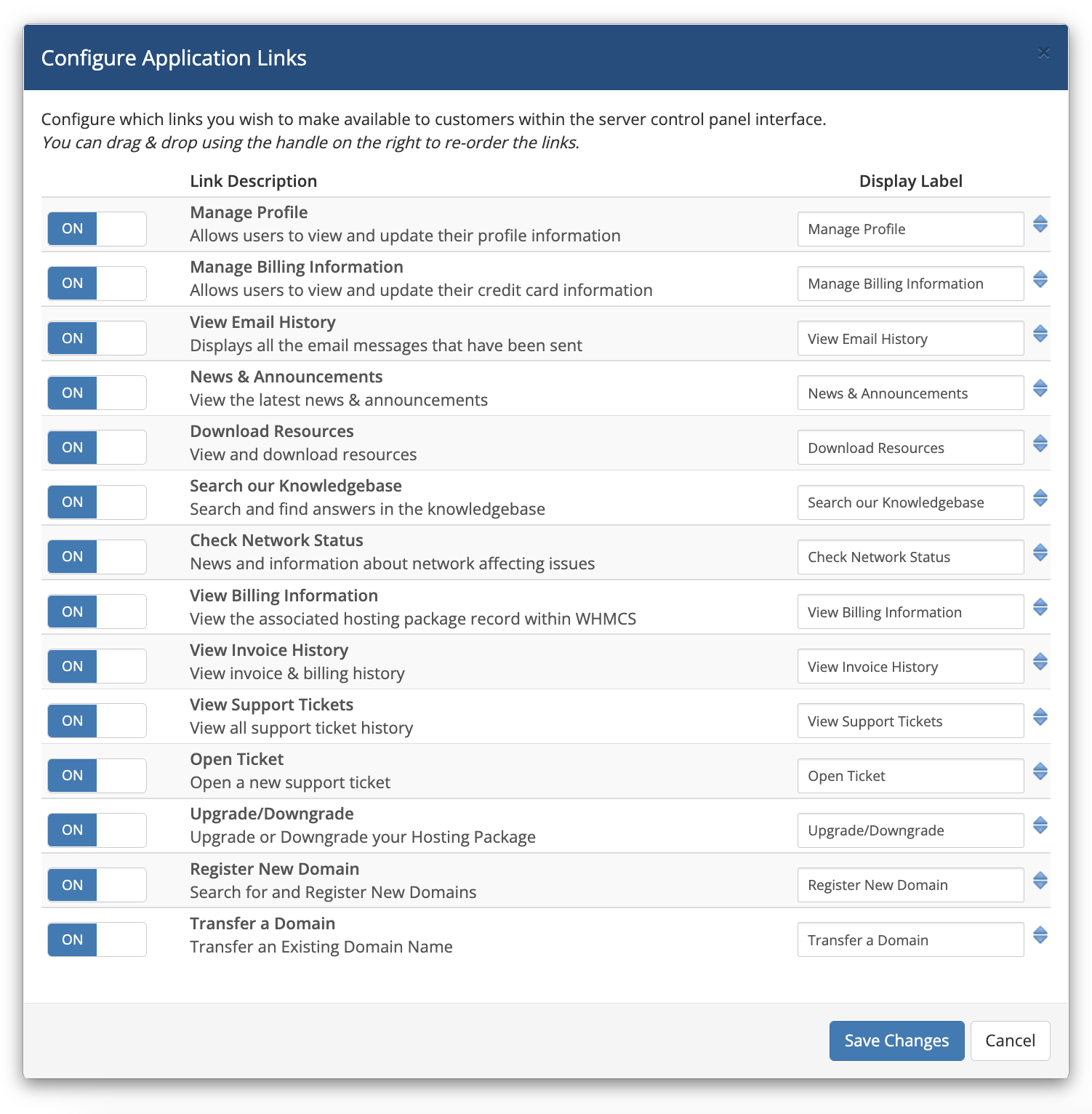Application Links
Application Linking allows end users and module developers to integrate with and use WHMCS Single Sign-On. WHMCS Single Sign-On allows trusted applications to authenticate users and send them to a desired page within the Client Area.
You can view a list of modules that support application linking at Configuration () > System Settings > Application Links or, prior to WHMCS 8.0, Setup > Application Links.
This requires the Configure Application Links permission, which WHMCS only assigns to Full Administrator-level users by default.
Contents
Supported Link Destinations
Supported link destinations include the following:
Ordering
- Upgrade/Downgrade
- Register New Domain
- Transfer a Domain
Support
- Open Ticket
- View Ticket History
- News & Announcements
- Download Resources
- Search our Knowledgebase
- Check Network Status
Account
- Manage Profile
- View Billing Information
- Manage Billing Information
- View Email History
- View Invoice History
You can configure which of the above links your end users see and their display label text.
Enabling Application Links
The Application Links feature requires a supported version of cPanel & WHM or WP Squared.
To enable Application Links:
- Go to Configuration () > System Settings > Application Links or, prior to WHMCS 8.0, Setup > Application Links. The system will display all of the installed modules that support Application Links.
- Set the toggle to On next to the application that you wish to enable it for.You can't enable Application Links until you configure at least one active server and assign it to the given module.The status indicator will update to reflect that the system has started provisioning links. When the process finishes, the status indicator will update to show that Application Links are active for the application.
Warning
If you navigate away from the page while the provisioning is still in progress, the system may not fully provision all of the links for all of the products or services.
Configuring Application Links
You can customize the provisioned Application Links on a per-application basis, allowing you to choose exactly which links your end users receive and display label they use.
You can configure this before or while you enable application links. The system syncs any changes and pushes them out across all your servers.
To configure application links:
- Go to Configuration () > System Settings > Application Links or, prior to WHMCS 8.0, Setup > Application Links.
- Click Configure for the application you wish to make changes for. The supported Application Links will appear (see above). From here, you can:
- Toggle the setting on or off to enable or disable a given link.
- Customise the display label for a link.
- Reorder the display of links within the third-party application.
- Click Save Changes. If you have enabled Application Links for the given application, the status indicator will update to reflect that the syncing of your configuration changes has begun. When the process finishes, the status indicator will update to show that Application Links are active for the application.
If you navigate away from the page while the sync is still in progress, the system may not fully sync all of the links for all of the products or services.
Disabling Application Links
To disable application links:
- Go to Configuration () > System Settings > Application Links or, prior to WHMCS 8.0, Setup > Application Links.
- Set the toggle to Off for the application that you wish to disable. The status indicator will update to reflect that the deprovisioning has begun. When the process finishes, the status indicator will update to show that Application Links are disabled for the application.
If you navigate away from the page while the deprovisioning is still in progress, the system may not fully deprovision all of the links for all of the products or services.
Reviewing the Application Link Log
Application Link provisioning has its own dedicated logging system. You will see View Log for each application that supports Application Links.
The log will display entries for the last provisioning operation that you performed for a given application (Activation, Configuration Changes, or Deactivation).
The log uses four logging levels:
- Debug — Event-based logging, like the start and completion of processes.
- Information — The system is attempting to provision links to a server that does not support Application Linking. Typically, this means it requires a newer version of the third-party application.
- Notice — No servers for the given application support Application Linking. Typically, this means it requires a newer version of the third-party application.
- Warning — Error messages that the application or module itself returned. These typically require attention.
Application Link Controls
There is a one-to-one relationship between a given cPanel or WP Squared account and a WHMCS client. Because there is not a multi-user system for cPanel or WP Squared accounts, you must use single sign-on to authenticate as the WHMCS account owner. While WHMCS can control which users have permission to use single sign-on to authenticate with cPanel or WP Squared, the reverse is not currently possible. For this reason, restricting single sign-on is possible at the user and account levels.
The client account owner can revoke the Single Sign-On permission for the user at Hello, Name! > User Management. Admins can remove this permission by clicking Manage User in the client's profile's Users tab.
The client account owner can disable single sign-on for the account at Hello, Name! > Security Settings. Admins can disable Allow Single Sign-On in the client profile's Profile tab.

